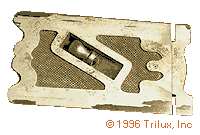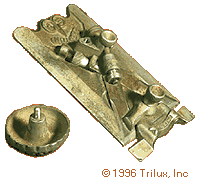![]()
Company History |
| Edward Preston & Sons Ltd., Birmingham, England, began in business in 1825, slowly growing over several generations into a large company specializing in plane, rule, measuring instruments of all description, woodworking tools and other assorted tools for various crafts and industries including can openers. They were bought out in 1932. Record Tools took over the Preston plane division. Record Tools, which is still currently in business as part of a large tool conglomerate, simplified the Preston line of planes almost as soon as they took it over. What they retained was the cast iron shoulder, rabbet, and side-rabbet planes. In addition, they offer copies of the Stanley series of bench planes. Record also manufacturers a full line of woodworking tools including their famous clamps and vises. |
Preston's Patented Adjustable Side Rabbet Plane - No. 1369 |
| This plane was made in two configurations, the one shown and a later "banana" handled model. A most elegant plane, the casting and knurling is right out of late Victorian design. Notice the "Patent" banner cast into the front bullnose attachment. The bullnose front detaches for close up work. The adjusters are twiddled, one from the front and one from the back, to move the blade in and out. In use the adjusters are fickle and are more of a clever gadget than a technical requirement. On later models the plane was simplified and the adjusters were dropped. To change blades, the handle is unscrewed to allow access to the blade assembly. The plane does not come with a fence, a rather useful accessory that is seen on a lot of later side rabbet planes. |
 |
Front view - There is a clear line where the front piece detaches
from the body so that the plane can be used in chisel mode for extreme close work. Most
chisel planes have a tendency to dig in and tear out so this feature was only used when
absolutely necessary. The adjusters (one in view in this picture) only serve to move the
blade. A thumbscrew, bearing down on a yoke, simultaneously clamps both blades. The skew
angle of the blades makes the blade hard to position and get perfect. Get a closer view of the object (32KB) |
 |
Back view - This particular tool shows considerable plating wear
around the throat. The picture clearly shows the exposed adjuster for setting the rear
blade. Get a closer view of the object (44KB) |
 |
Front view with the handle removed. In a truly Byzantine design that
only Victorian engineers would think of, to remove the blades for sharpening you must
follow the following procedure: Unscrew the handle to expose the end post which holds one
of the screw adjusting knobs. Loosen the thumbscrew behind the end post and then pull on
the top knurled Get a closer view of the object (40KB) |
| SPECIFICATIONS | ||
|---|---|---|
| DIMENSIONS | Length | 5 1/2" |
| Width | 2 7/8" | |
| Cutter Width | 1/2" | |
| Blade Thickness | 0.070" | |
| MATERIALS | Body | Nickel Plated Iron casting |
| GENERAL | Year | Unknown |
| Cost in 1909 | 7/6 (7 shillings sixpence) | |
Suggested further reading: |
Copyright 1999 01 Inc., NYC